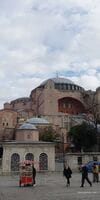Hagia Sophia (Turkish name: Ayasofya) is a mosque in Istanbul, which has been an Orthodox church, mosque and museum throughout history.
Today, Hagia Sophia is a mosque-museum, entrance fee for tourists, and is officially called: Great Mosque of Hagia Sophia (Aya Sophia-i Kebirtur Mosque, Turkish name: Ayasofya-ı Kebir Camii).
The mosque is also known as St. Sophia Cathedral.
Hagia Sophia is one of the greatest world-famous monuments and examples of Byzantine culture, as well as a symbol of the "Golden age" of Byzantium.
The mosque is located in the central part of the European side of Istanbul, in the Sultanahmet district.
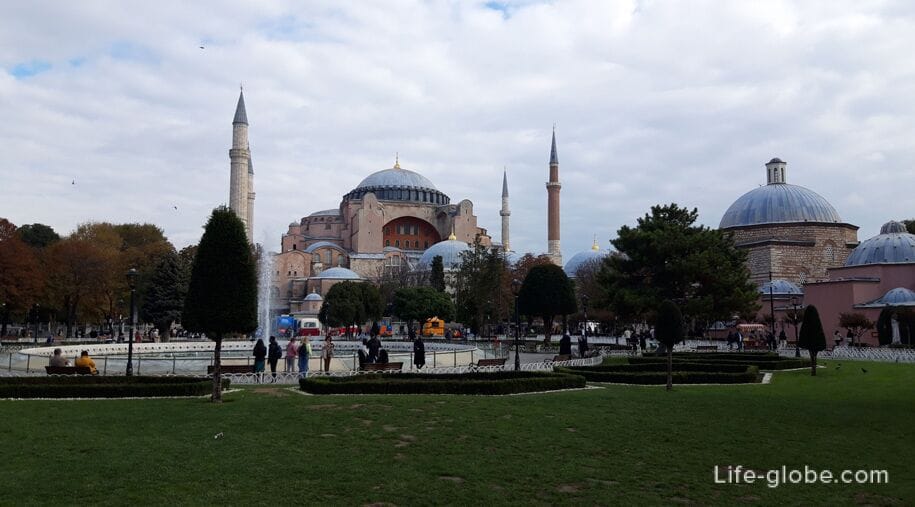
Today's cathedral is the third in the history of the cathedral, standing in its current place.
The first construction of the Orthodox Hagia Sophia was begun during the reign of Constantine I, who adopted Christianity as the official religion of the Roman Empire. This structure was built as a basilica with a wooden roof and was called the "Great Church"; it was opened under Constantine II in 360. This cathedral was largely destroyed as a result of a fire that broke out during the uprising that began in 404.
The second Hagia Sophia was built by Theodosius on the site of the first and opened for worship in 415. This structure, which also had the shape of a basilica with a wooden roof, was destroyed by rebels during the uprising of Nika against Emperor Justinian in 532.
Immediately after the uprising, Emperor Justinian I decided to build a cathedral that would be much larger and more magnificent than the first two. So, in 532-537, the third Hagia Sophia was erected.
The cathedral has long been used as the Orthodox Imperial Church of Eastern Rome. The cathedral suffered from destruction and natural disasters, but has always been restored.
During the Latin occupation of Istanbul from 1204 to 1261, Hagia Sophia was transformed into a cathedral belonging to the Roman Catholic Church.
In 1453, after the Ottomans captured Constantinople, the cathedral was converted into a mosque. Since the time of Sultan Mehmed II the Conqueror, the Ottomans have paid great attention to the Hagia Sophia Mosque, which they accepted and appreciated as a symbol of conquest, carried out repair and repair work and made the mosque a much stronger structure than before, and also erected additions to the cathedral, including added minarets (type of towers in the mosque), placed a mihrab (direction of prayer) and built madrasahs (schools) next to the mosque. Also, other architectural changes were subsequently made - buttresses were added, turbets (tombs-mausoleums), a library, a dining room, and a fountain were erected on the territory of the cathedral. Thus, the mosque has become a complex that performs religious and cultural tasks.
Then restorations were carried out in the cathedral. In particular, some Byzantine Orthodox mosaics were cleared, which can still be seen today.
In 1930, the mosque was closed for restoration. In 1935, according to the decree of the Turkish government, the mosque received the status of a museum.
In 1985, St. Sophia Cathedral, among other monuments of the historical center of Istanbul, was included in the UNESCO World Heritage List.
In 2020, in accordance with the manifesto of Turkish President Recep Tayyip Erdogan, the Hagia Sophia Museum again became a mosque, which it is to this day.
Today, Hagia Sophia is an outstanding monument of Byzantine architecture with the world cultural heritage of mankind, as well as one of the main attractions of Istanbul, attracting numerous tourists.
Hagia Sophia has four minarets, and the giant dome system of the mosque with arched windows is a masterpiece of architectural thought of its time.
The walls of the mosque are very strong, which, according to Turkish researchers, is achieved by adding ash leaf extract to the mortar.
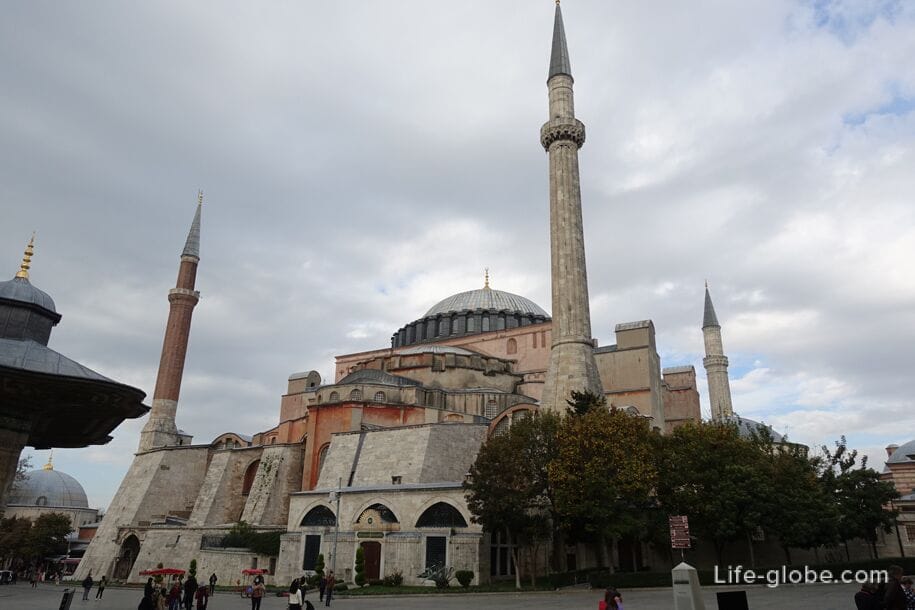
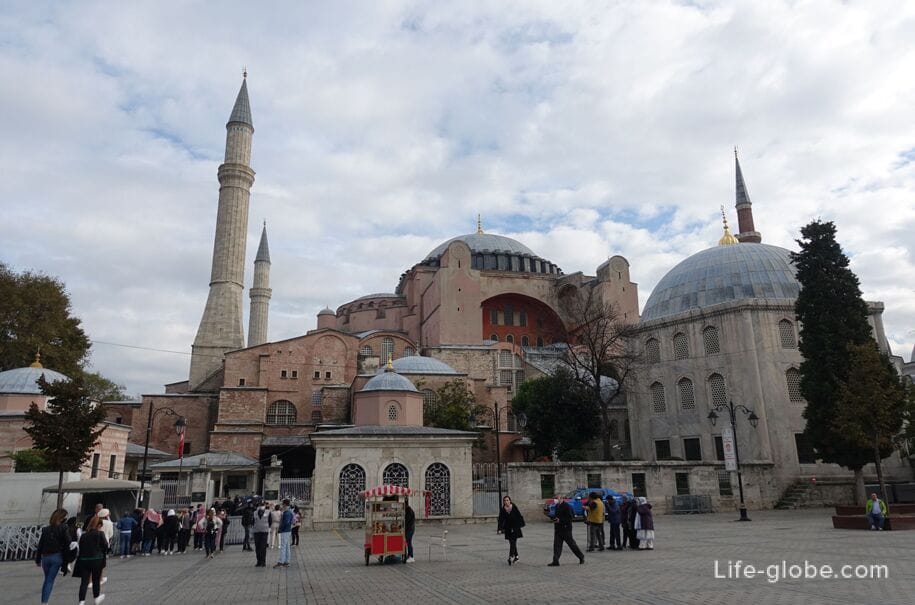
The interior of Hagia Sophia cannot fail to make an impression, and, above all, due to the fact that it has absorbed several cultures and religions.
Inscriptions in Scandinavian runes are found on the marble parapets of the Hagia Sophia Cathedral. There are Slavic graffiti inscriptions and marble urns.
In the mosque you can see unique Orthodox mosaics, including mosaics in tympanums over the south-western entrance and over the Imperial Gate (the gate-entrance, which once could only enter the emperor with his personal retinue and guards) with Christ the Almighty. The mosaic of the apse with the image of the Virgin and Child and the dome mosaic also attracts attention.
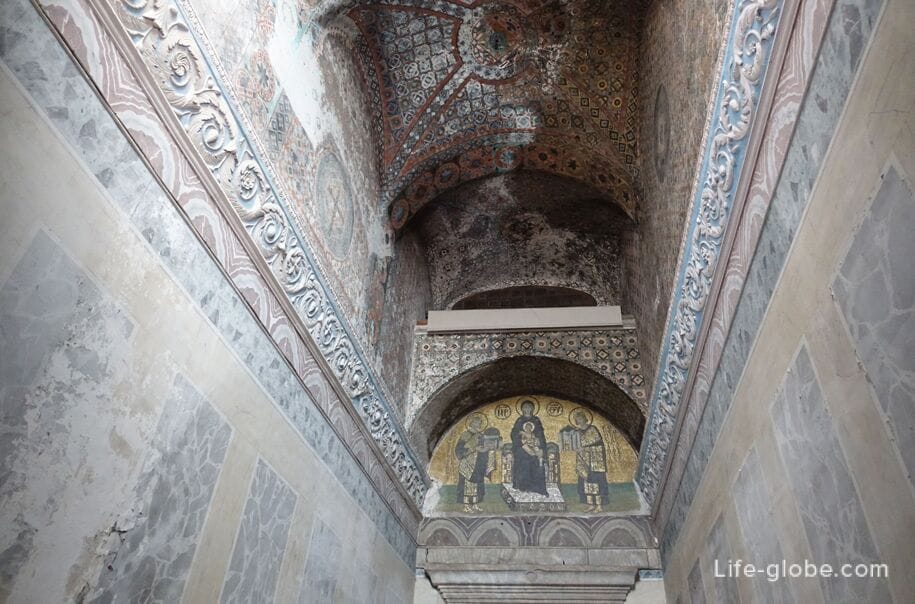
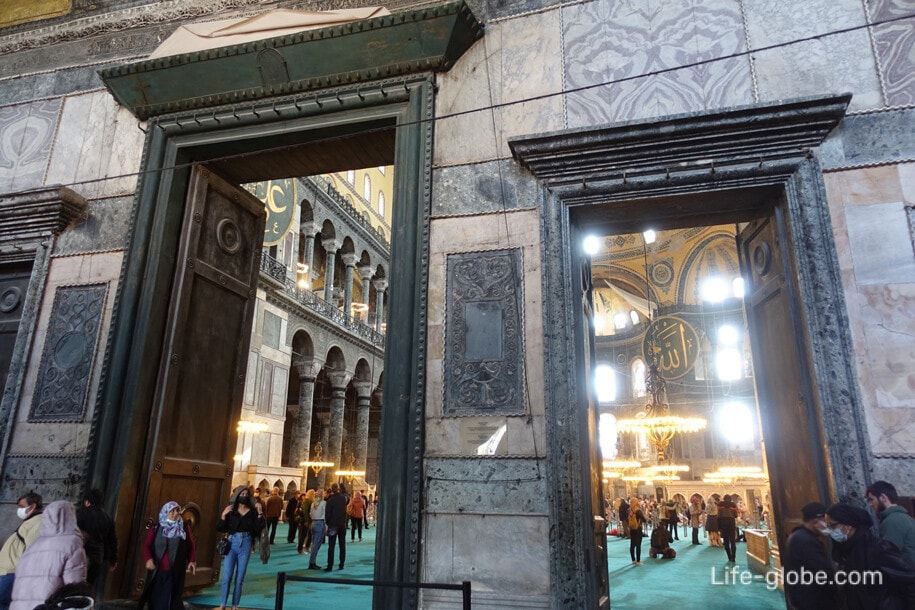
Narthex - passageways



The main hall of the mosque is spacious and has three naves: the middle one is wide, the side ones are narrower, which have two tiers each.
The naves are separated by massive pillars supporting arches.
The interior frescoes can be partially covered with a cloth.

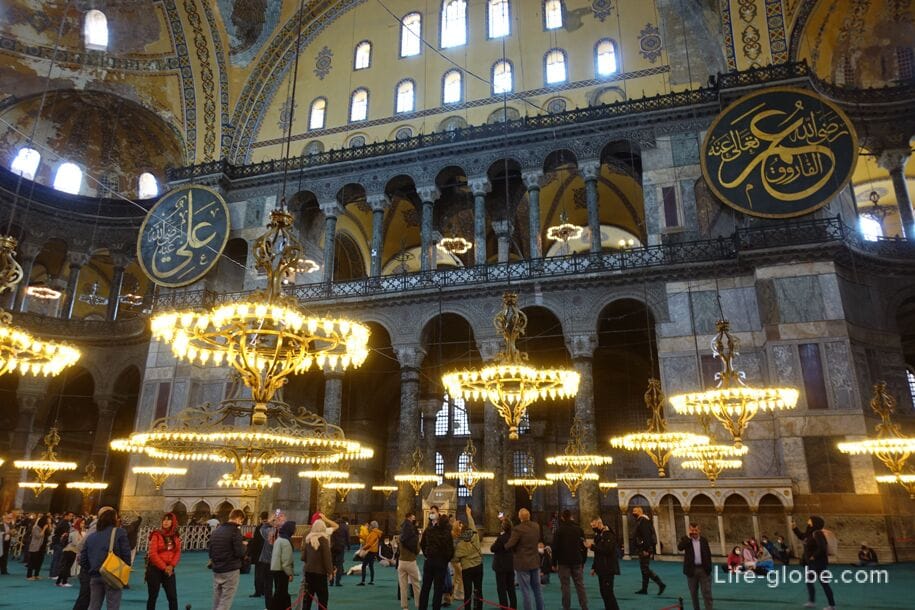
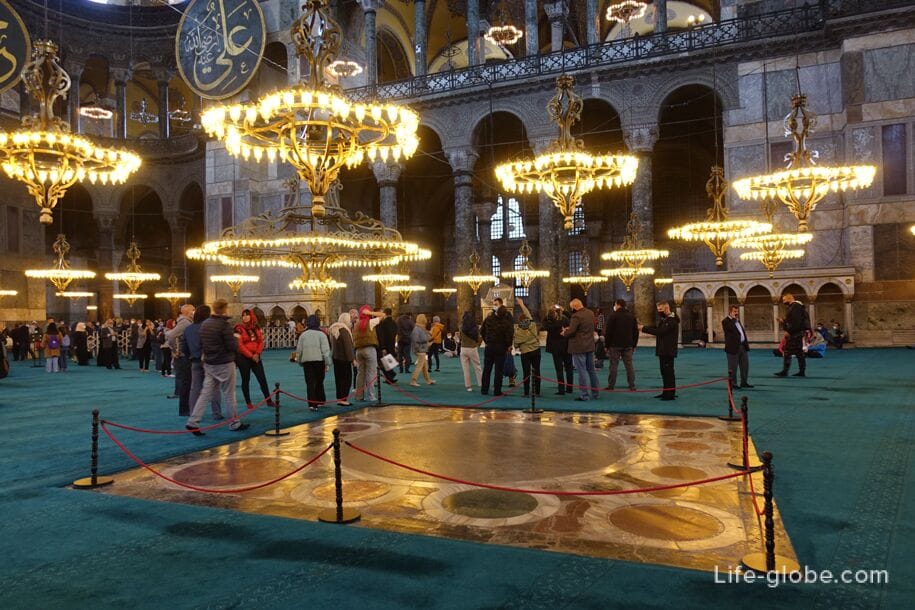
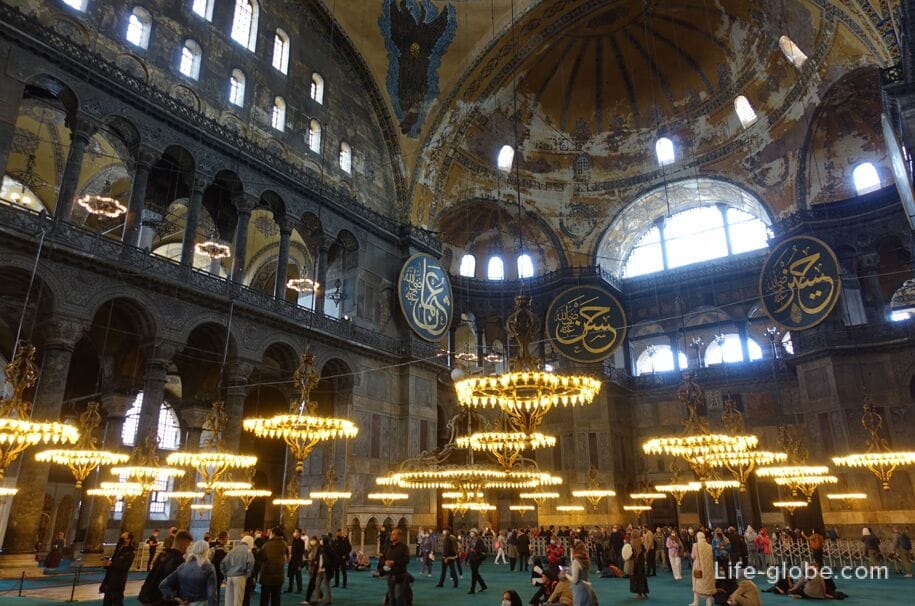
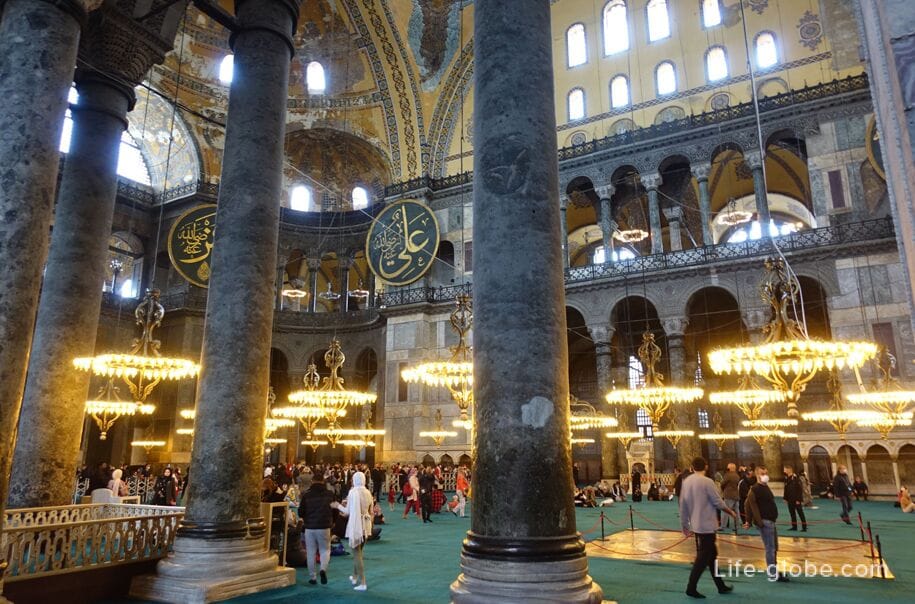
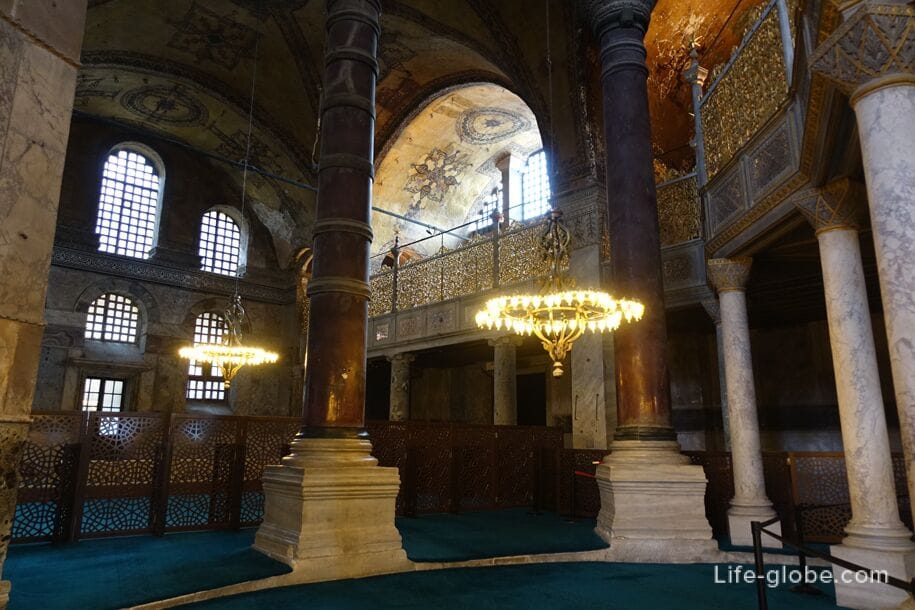
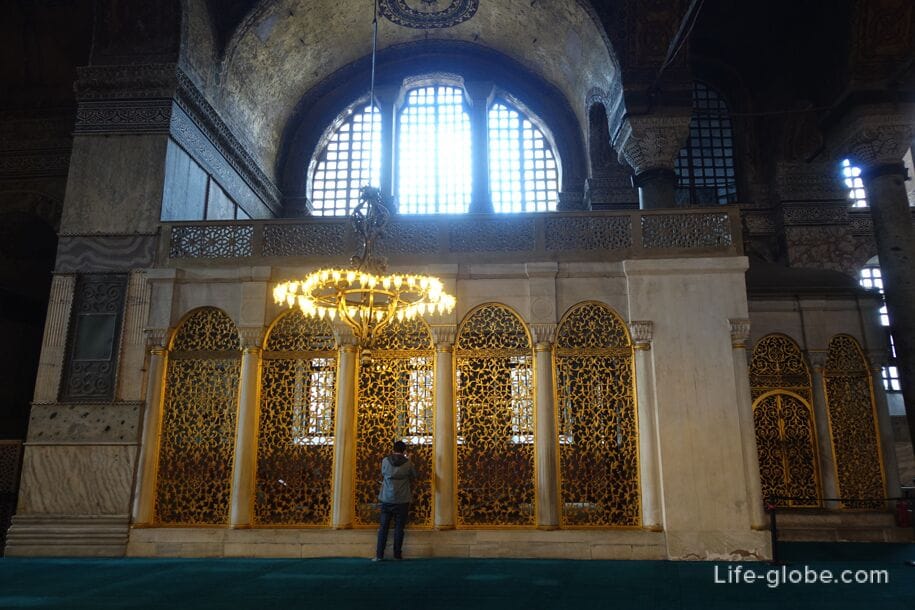

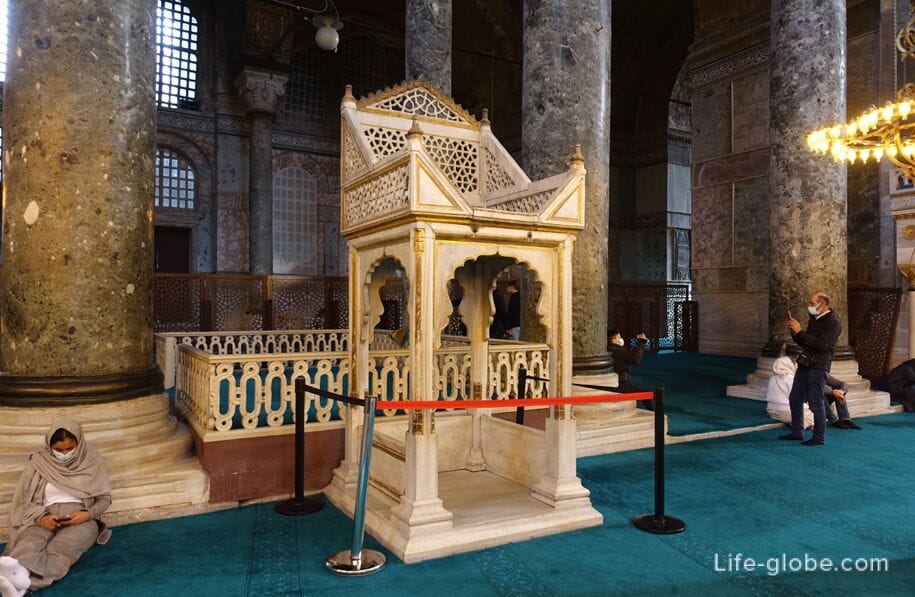
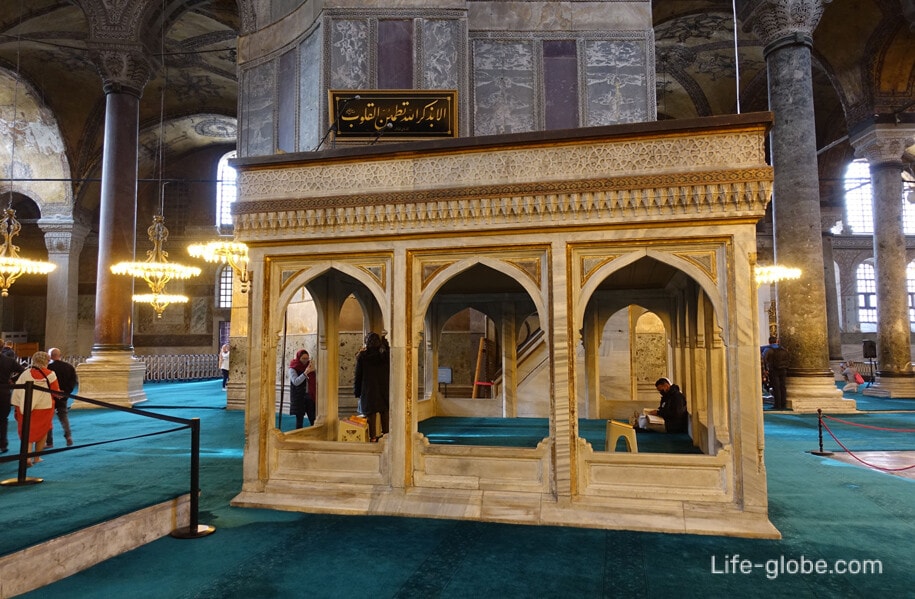
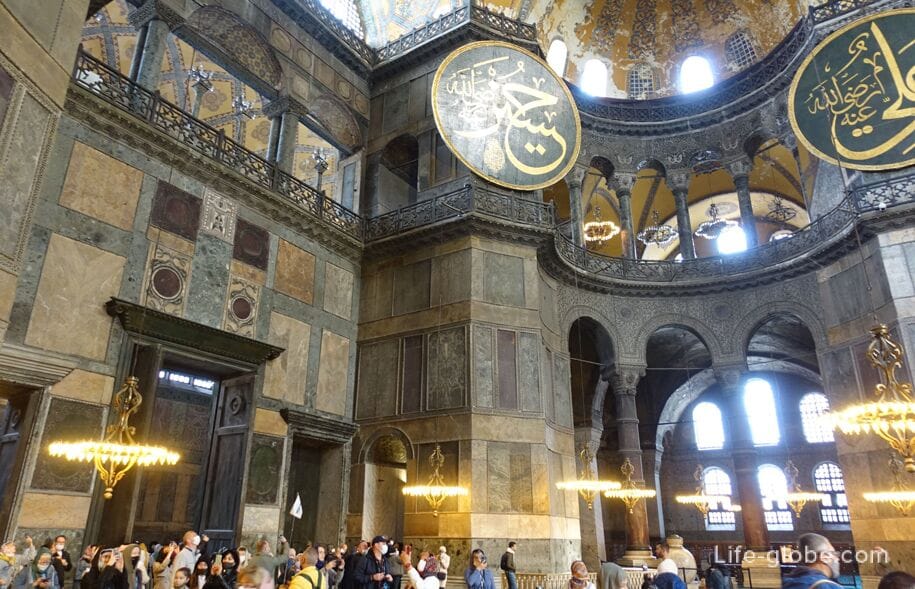


Notable among the Islamic elements in the Ay-Sofia Mosque are: the mihrab, located in the apse; the Sultan's lodge, decorated by the Fossati brothers; the minbar (pulpit or tribune in the cathedral mosque), from where the imam preached sermons.
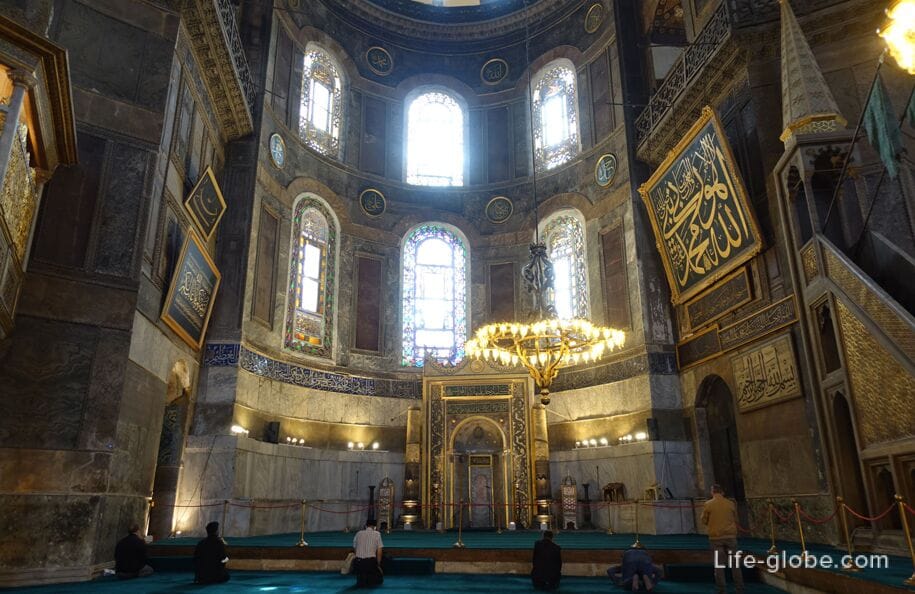
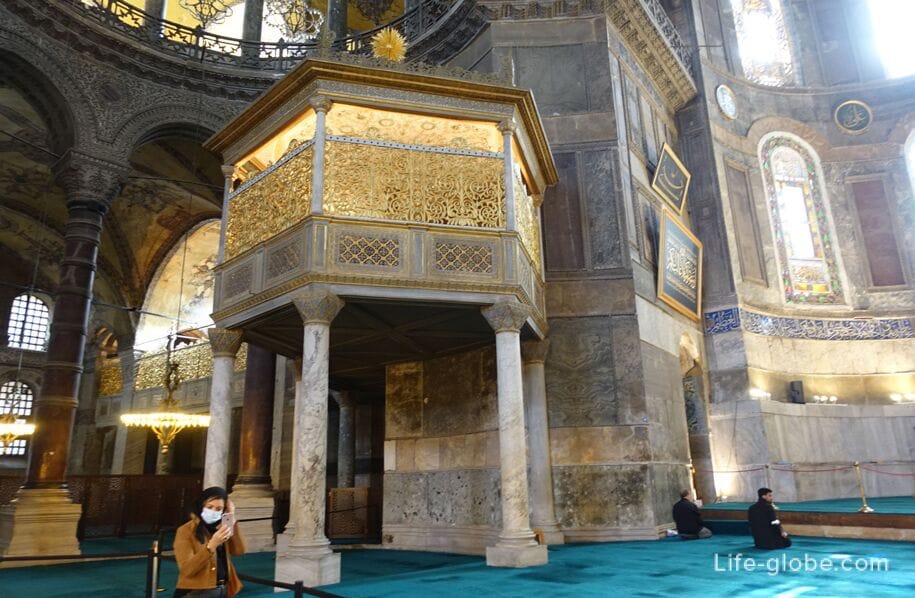

The "Weeping Column" - one of the columns in the mosque hall, which is covered with copper, also attracts attention.
The column is also known as the "pillar of desires" or "pillar of sweat".
There is a hole in the column and legend has it that it has been wet since Gregory the Wonderworker appeared near the column in 1200. It is believed that a person who has stuck his thumb into the hole and, feeling the moisture, should outline a circle around with his palm and then he will be cured of many diseases and his wish made during this action will be fulfilled.
The approach to the "Crying Column" may be closed.
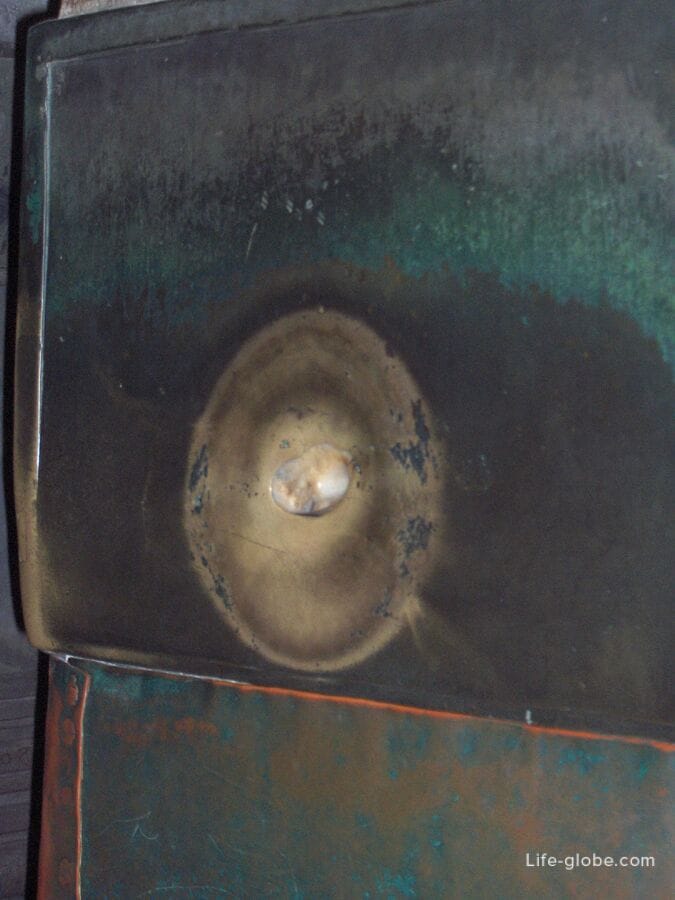
Cats from the Hagia Sophia Mosque

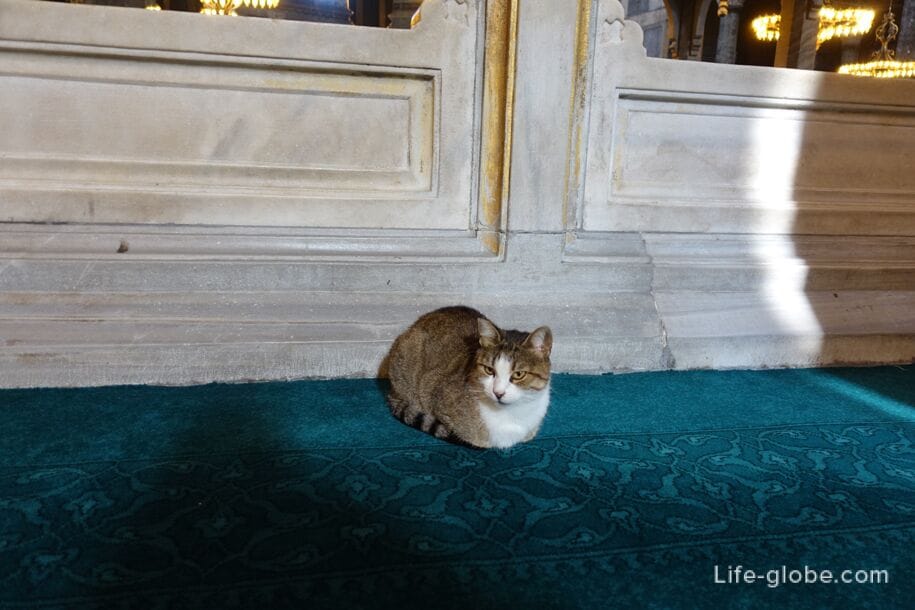
There are underground spaces under the mosque in the form of maze-like passages, which have been studied and are still being studied.
In the courtyard of the mosque there are mausoleums-tombs and burials: Mehmed III, Selim II, Murad III and princes.
In the baptistery of the Byzantine era there are tombs of Sultan Mustafa I and Ibrahim I.
There is also a large marble baptismal font.
In the courtyard you can see parts of the excavations and the remains of columns.
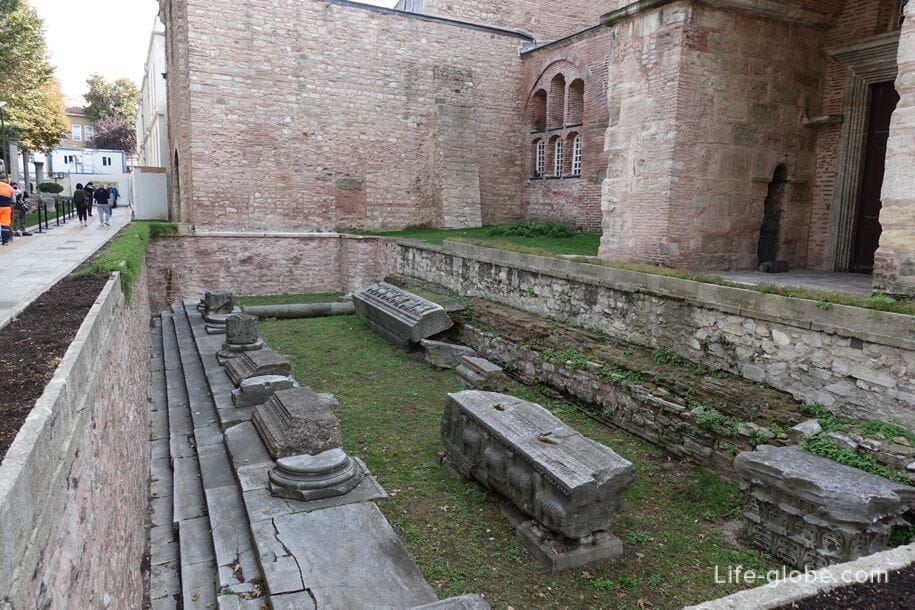

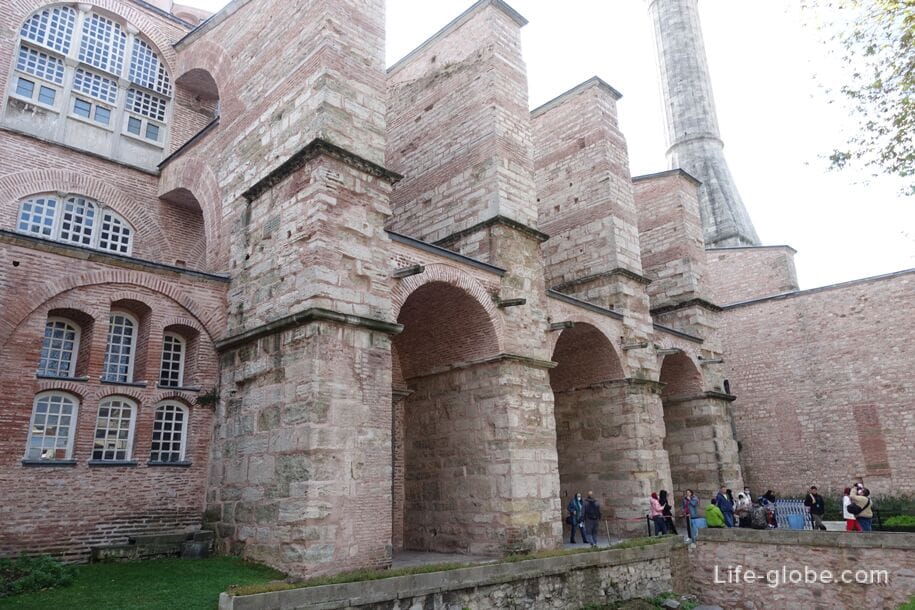
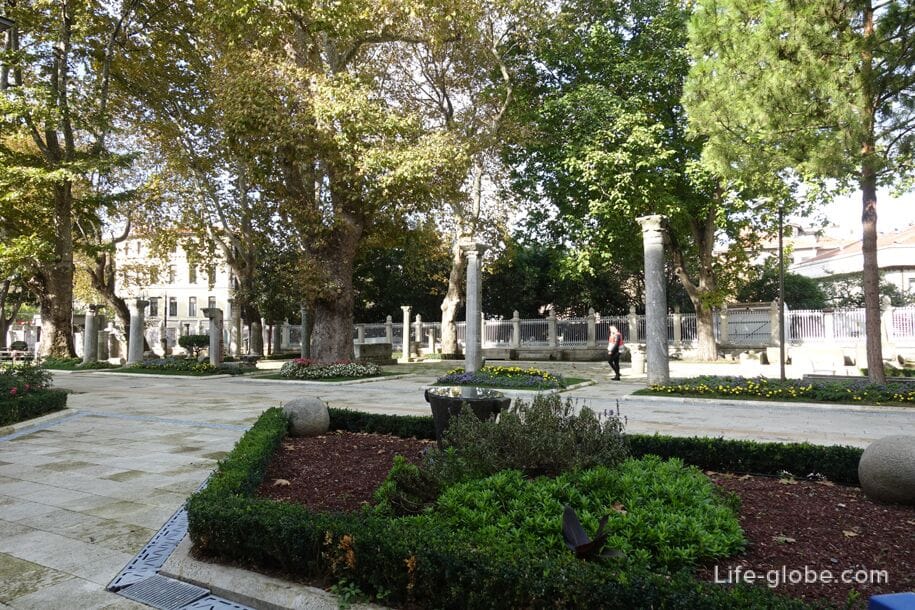
Scheme of the Hagia Sophia Mosque

1 - input; 2 - Imperial gate; 3 - the weeping column; 4 - mihrab (altar); 5 - Minbar; 6 - bed of the Sultan; 7 - the omphalos ("navel of the world"); 8 - marble urn from Pergamon; a - the baptistery of the Byzantine era, the tomb of Sultan Mustafa I; b - minarets of Sultan Selim II.
Practical information
The Hagia Sophia Mosque is located on the European side of Istanbul, in the old part of the city, in the Sultanahmet district, near Blue Mosque and Topkapi Palace Complex.
The address of the Hagia Sophia Mosque: Sultan Ahmet, Ayasofya Meydanı No:1, 34122 Fatih/Istanbul, Turkey.
Coordinates of the Hagia Sophia Mosque: 41°00'31.0"N 28°58'48.0"E (41.008611, 28.980000).
You can get to the mosque on foot from the ferry piers near the Galata Bridge; from the tram stop T1 "Sultanahmet"; from the metro station Vezneciler (green line M2) on foot about 2 kilometers. You can also get there by taxi, rented car, or by taking a tour on the Istanbul Hop-On Hop-Off tour bus (there are tickets for 1, 2 or 3 days).
Tickets for the Istanbul sightseeing bus can be purchased here →
The mosque is open to visitors at any working time, except for prayer (prayer) hours. Since this is a functioning mosque, it should be visited with a naked woman covered; as well as with covered knees and shoulders (not in T-shirts and shorts, women + short skirts), both men and women.
When entering the main hall, you must take off your shoes.
Entrance to the mosque, its territory and the tombs of the sultans is free (free).
The website of the Hagia Sophia Mosque: ayasofyacamii.gov .
You can also visit and (or) see the Hagia Sophia Mosque with one of the excursions in Istanbul
All accommodation facilities in Istanbul, including in the historical center, on the European and Asian sides of the city, can be viewed and booked here




